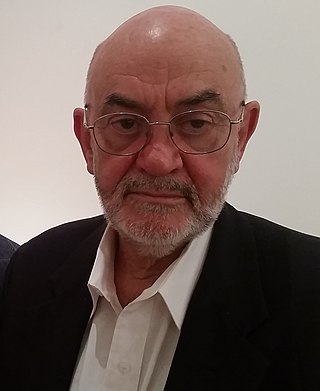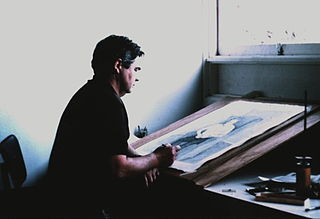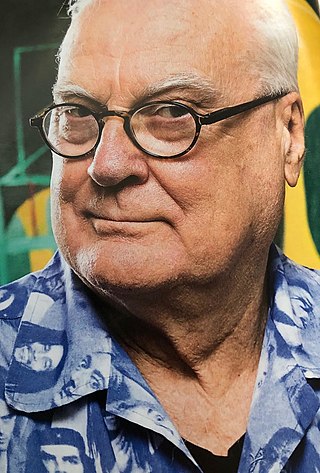
Helen Frankenthaler was an American abstract expressionist painter. She was a major contributor to the history of postwar American painting. Having exhibited her work for over six decades, she spanned several generations of abstract painters while continuing to produce vital and ever-changing new work. Frankenthaler began exhibiting her large-scale abstract expressionist paintings in contemporary museums and galleries in the early 1950s. She was included in the 1964 Post-Painterly Abstraction exhibition curated by Clement Greenberg that introduced a newer generation of abstract painting that came to be known as color field. Born in Manhattan, she was influenced by Greenberg, Hans Hofmann, and Jackson Pollock's paintings. Her work has been the subject of several retrospective exhibitions, including a 1989 retrospective at the Museum of Modern Art in New York City, and been exhibited worldwide since the 1950s. In 2001, she was awarded the National Medal of Arts.

Rick Amor is an Australian artist and figurative painter. He was an Official War Artist for Australia.

John Brack was an Australian painter, and a member of the Antipodeans group. According to one critic, Brack's early works captured the idiosyncrasies of their time "more powerfully and succinctly than any Australian artist before or since. Brack forged the iconography of a decade on canvas as sharply as Barry Humphries did on stage."
Dorothy Napangardi was a Warlpiri speaking contemporary Indigenous Australian artist born in the Tanami Desert and who worked in Alice Springs.

Ernest William Buckmaster (1897–1968) was an Australian artist born in Victoria. He won the Archibald Prize in 1932 with a portrait of Sir William Irvine. He also served as an Australian war artist during World War II.
Jenny Sages is an Archibald Prize People's Choice Award winning Australian artist born 1933 in Shanghai, China. She is known for her abstract landscape paintings and portraits. She arrived in Australia in 1948. After being expelled from East Sydney Tech, Jenny moved to New York to study at Franklin School of Art. She was a freelance writer and illustrator for Vogue Australia until the 1980s before starting full-time painting in 1985 at the age of 52. Her career transformation was greatly influenced by a trip to Kimberley, Western Australia, where she felt enchanted by the local indigenous culture. Her unique style is created using wax and pigments and the minimal use of brushes.

The Art Gallery of South Australia (AGSA), established as the National Gallery of South Australia in 1881, is located in Adelaide. It is the most significant visual arts museum in the Australian state of South Australia. It has a collection of almost 45,000 works of art, making it the second largest state art collection in Australia. As part of North Terrace cultural precinct, the gallery is flanked by the South Australian Museum to the west and the University of Adelaide to the east.
The Fleurieu Art Prize is a non-acquisitive award, open to Australian visual artists aged 18 years and older. The Prize encompasses any two- or three-dimensional artwork submissions that follow an annual thematic concept and includes a monetary gift and significant exposure for the artists and their works. Exhibitions for the Prize are held in various South Australian locations, including McLaren Vale and Goolwa, garnering attention and merit from tourists, art appreciators, and critics alike at places such as; Stump Hill Gallery, Fleurieu Visitors Information Centre, the Fleurieu Art House and the Hardy's Tintara Sculpture Park.

Gareth Sansom is an Australian artist, painter, printmaker and collagist and winner of the 2008 John McCaughey Memorial Prize of $100,000.
Paul Margocsy is an Australian artist, known primarily for his watercolour paintings of Australian birds. Though he has never received any formal art training, he is internationally recognised as one of Australia's best wildlife artists. His art is collected both in Australia and internationally alike.
Fiona Lowry is an Australian painter who airbrushes pale colours to portray landscapes with people in them. The landscapes are beautiful and ambiguous, provoking the dangerous side of wilderness. Lowry also paints portraits and won the 2014 Archibald Prize at the Art Gallery of New South Wales with a portrait of Penelope Seidler. She is represented in the National Gallery of Australia, as well as the state galleries of Australia and in private collections.
Ivan Durrant is an Australian painter, performance artist and writer. Known for creating art with "great shock value", such as the 1975 "Slaughtered Cow Happening" outside the National Gallery of Victoria, Durrant is often described as the enfant terrible of Australian art. The larger proportion of Durrant's work consists of paintings using a self-developed style of "Super-Realism".

The Islamic Museum of Australia (IMA) is a community museum in Thornbury, Melbourne, Australia. It began as a not-for-profit foundation founded in May 2010 with the purpose of establishing the first Islamic museum in Australia. It aims to showcase the artistic heritage and historical contributions of Muslims in Australia and abroad through the display of artworks and historical artefacts.
Tony Albert is a contemporary Australian artist working in a wide range of mediums including painting, photography and mixed media. His work engages with political, historical and cultural Aboriginal and Australian history, and his fascination with kitsch “Aboriginalia".

Judith Ann Darragh is a New Zealand artist who uses found objects to create sculptural assemblages. She has also worked in paint and film. Darragh is represented in a number of public collections in New Zealand. In 2004, The Museum of New Zealand Te Papa Tongarewa held a major retrospective of her work titled Judy Darragh: So... You Made It?
Julie Gough is an artist, writer and curator based in Tasmania, Australia.
Joan Ross is an Australian artist based in Sydney who works across a range of mediums including drawing, painting, installations, sculpture and video. Her work investigates the legacy of colonialism in Australia, particularly the effects colonialism has had on Indigenous Australians.
Nyapanyapa Yunupingu was an Australian Yolngu painter and printmaker who lived and worked in the community at Yirrkala, Arnhem Land, in the Northern Territory. Yunupingu created works of art that drastically diverge from the customs of the Yolngu people and made waves within the art world as a result. Due to this departure from tradition within her oeuvre, Yunupingu's work had varying receptions from within her community and the broader art world.
Helen Johnson is an Australian artist producing large-scale paintings who also works as a lecturer, researcher and curator. Her artworks and practice reflect her views on colonialism, consumerism, the environment and personal accountability.

Djon Mundine is an Aboriginal Australian is a member of the Bandjalung people of northern New South Wales with an extended career as a curator, activist and writer. His career has helped revolutionize the criticism and display of contemporary Aboriginal art. He worked as art and craft advisor at Milingimbi in the Crocodile Islands in 1979 and curator at Bula-bula Arts in Ramingining in Arnhem Land where he originated Australia’s greatest artwork, the Aboriginal Memorial, on permanent display at the National Gallery of Australia.










